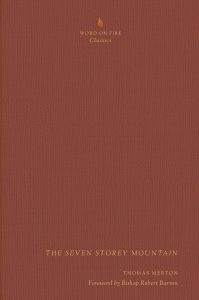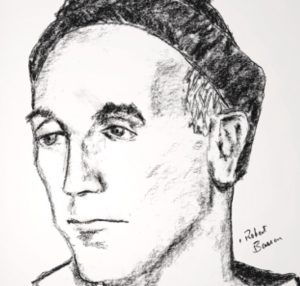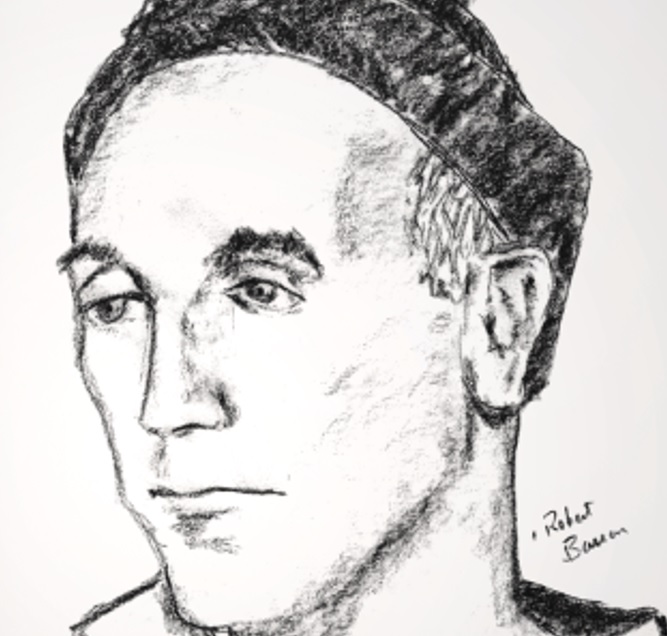
The late Trappist monk Thomas Merton’s autobiographical work The Seven Storey Mountain reads like a coming-of-age story, a theological reflection and sometimes like a novel sprinkled with wry humour, wit and tragedy. One of Merton’s contemporaries was British novelist Evelyn Waugh. We know that as a young man, Merton read and enjoyed Waugh’s novels. Like Waugh, Merton was a convert to Roman Catholicism. Some of Merton’s sharp-tongued humour, his occasional flippancy, the manner in which he derides modern culture and society, and the often ornamental narration does more than simply remind me of Waugh — much of this feels like nearly a mirror image of the novelist’s views and style. While I occasionally sensed a certain degree of immaturity in Merton’s first publication, particularly in his convert’s zeal, his passing conceit and in some sweeping declarations that he makes, it’s also this initial work that shows him to be an exceptionally good and engaging writer.
Merton experienced a transient and unconventional childhood — one that was first marked by the death of his mother and then later the death of his father, as well as settling and re-settling in different countries, including France, Britain and the United States. Merton was only six years old when his mother died, and while some of the memories he shares of her are quite vivid, there is nonetheless a fleeting sense to them. They are snippets and brief impressions from a young child’s mind. When his mother becomes terminally ill and hospitalized, she says goodbye to her son in a letter. This memoir depicts the disorientation of a young child dealing with death. The depiction is genuine and beautiful in its simplicity.
As a child, Merton was very much attached to his artist father who led a somewhat Bohemian life. That attachment persisted even though Owen Merton spent lengthy periods of time away from his son, as he painted and prepared for exhibits. During these months, young Merton lived in a boarding school, or with various family members or with family friends. While Owen Merton travelled and painted, and while Thomas lived in different homes in Europe, his little brother, John Paul Merton, lived in the United States with Merton’s maternal grandparents, known affectionately as Pop and Bonnemaman. Merton paints a vivid picture of his caring, financially secure grandparents from Long Island and starkly contrasts their personalities. Pop was outgoing, self-confident and almost hyperactive. Bonnemaman, on the other hand, was quiet, measured and often tried to put the brakes on Pop’s frenzied drive.
Owen Merton died in 1931 of a brain tumour, when Thomas was 16 years old. He suffered in hospital for an extended period of time, as the tumour weakened him incrementally, and caused him pain and even disfigurement. Merton describes one of his final visits to his father poignantly, weaving it into a reflection on that eternal question of the meaning of suffering, if indeed it has any meaning at all:
I said: ‘How are you, Father?’
He looked at me and put forth his hand, in a confused and unhappy way, and I realized he could no longer even speak. But at the same time, you could see that he knew us and knew what was going on, and that his mind was clear, and that he understood everything.
But the sorrow of his great helplessness suddenly fell upon me like a mountain. I was crushed by it. The tears sprang to my eyes. Nobody said anything more. I had my face in the blanket and cried. And poor Father wept, too. The others stood by. It was excruciatingly sad. We were completely helpless. There was nothing anyone could do. When I finally looked up and dried my tears, I noticed that the attendants had put up screens all around the bed. I was too miserable to feel ashamed of my un-English demonstration of sorrow and affection. And so we went away.
What could I make of so much suffering? There was no way for me, or for anyone else in the family, to get anything out of it. It was a raw wound for which there was no adequate relief. You had to take it, like an animal. We were in the condition of most of the world, the condition of men without faith in the presence of war, disease, pain, starvation, suffering, plague, bombardment, death. You just had to take it, like a dumb animal. Try to avoid it, if you could. But you must eventually reach the point where you can’t avoid it any more. Take it. Try to stupefy yourself, if you like, so that it won’t hurt so much.
Merton’s family and his childhood experience was mostly non-religious. There are brief episodes of the young Merton visiting a Quaker meeting house in New York or attending Anglican or Lutheran services, but that’s about all. He does describe his father having a deep, personal spirituality and faith — and indeed being the only member of his family with a formed and reflective faith in God, owing in part to the fact that, as Merton notes, the artistic experience can be “a natural analogue of mystical experience.” When the period of mourning passed after Owen Merton’s death, Thomas describes feeling a certain sense of liberation — although not a particularly happy one. It was a feeling of total freedom to do as he pleased in, and with the world as he headed into adulthood. Merton found, however, that after having immersed himself in the pleasures of the world, and having appropriated them, he was empty and even “gutted.”
There’s no shortage of flippancy, but also self-depreciating humour in how Merton describes his university years, particularly at Columbia. He had first studied at Cambridge, but as he didn’t show any signs of excelling, and as a future career in the British diplomatic service fell further out of reach, his godfather convinced him to cut his losses and quit Cambridge. He returned to the U.S. and landed at Columbia. He briefly dabbled in communism, but based on how he recounts this period, it doesn’t seem that there was ever any depth or seriousness to his involvement in this movement. Instead, it appears as though he was just seeking meaning and community. Merton presents a dichotomous picture of university politics in the 1930s: on the one side were the communists and on the other were the fraternity boys, who played the role of the fascists. After quitting communism, Merton was hazed into a fraternity. He suggests that the hazing rituals were scandalous, but provides no details.
Whether speaking of communist groups, fraternities or society in a more general sense, Merton depicts modern civilization as heartless and meaningless. One of his fraternity brothers, Fred, goes missing in New York City and his corpse is eventually found in a Brooklyn canal. At about the same time, Merton is enrolled in a Columbia University course called Contemporary Civilization. It’s a catch-all survey course and, in a peculiar way, requires the students to visit a morgue. Here we read a strikingly vivid condemnation of modern society.
Our famous course in Contemporary Civilization had involved me, one winter afternoon, in a visit to the Bellevue Morgue, where we had seen rows and rows of iceboxes containing the blue, swollen corpses of drowned men along with all the other human refuse of the big, evil city: the dead that had been picked up in the streets, ruined by raw alcohol. The dead that had been found starved and frozen lying where they had tried to sleep in a pile of old newspapers. The pauper dead from Randalls Island. The dope-fiend dead. The run-over. The suicides. The dead Negroes and Chinese. The dead of venereal disease. The dead from unknown causes. The dead killed by gangsters. They would all be shipped for burial up the East River in a barge to one of those islands where they also burned garbage…I have never forgotten the awful, clammy silence of the city morgue at Bellevue, where they collected the bodies of those who died of contemporary civilization.
Personal experience, much reading and study, a dismay with the emptiness he perceived in modern western society and a dark view of Protestantism, where virtue was denigrated and misunderstood as prude behaviour, all conspired to draw Merton toward his conversion to Catholicism. Among the works that had the greatest impact on him were the writings of William Blake and Etienne Gilson’s Spirit of Mediaeval Philosophy. Later Dante also left a significant impression on Merton — the title of this autobiography is a direct nod to the Medieval author. Curiously, a Hindu monk called Mahanambrata Brahmachari also helped open the doors of Catholicism to Merton. During the monk’s visits to the United States, Merton had the opportunity to encounter and speak with Brahmachari — a man he saw to be genuine and deeply contemplative in his spirituality. He also shared Merton’s misgivings about modern western culture and Protestantism, although was quite light-hearted and gentle in his critique. Brahmachari encouraged the young Merton to read the works of St. Augustine as a way to develop his own spirituality and contemplative stance.
When in 1938 Merton begins attending Mass for the first time, he juxtaposes what he sees of pre-Vatican II Catholic worship with the Protestant experience. He is moved by the fact that in this liturgy, the emphasis is not on gathering as a community of faithful and as neighbours, “with at least half an eye for one another, if not all of both eyes,” but that Catholics were much more conscious of God at Mass, than of those sitting around them. “The priest was in the sanctuary with the two altar boys, and was busy at the altar with something or other which I could not see very well, but the people were praying by themselves, and I was engrossed and absorbed in the thing as a whole: the business at the altar and the presence of the people,” Merton observes. The Second Vatican Council, in implementing sweeping liturgical reforms, addressed exactly this: people sitting apart, wrapped up in their personal piety and private devotional world during Mass. Merton, however, is moved by the pre-Vatican II liturgical experience.
At the same time, the nineteenth century poet and priest Gerard Manley Hopkins heightened Merton’s interest in the Jesuits. Soon after, a Jesuit character in Evelyn Waugh’s novel Vile Bodies, Father Rothschild, rendered that interest even more acute. Merton sought out the Pastor of Corpus Christi Church in the Morningside Heights area of Manhattan and told him that he wanted to become a Catholic. The priest gave the young Merton a set of books to read and sent him on his way, asking him to first explore these, to pray about them, and to give it a week to see how he feels about everything. Merton confirmed his desire to convert, and he was assigned a priest in his early thirties, Father Moore, to become his instructor, leading him through catechesis. He studied with Father Moore twice a week for six weeks. And when he heard a homily from this priest on the subject of Hell, which reminded Merton of that iconic preaching in James Joyce’s The Portrait of the Artist as a Young Man, he requested that his baptism be expedited.
Reflecting on hell, Merton writes: “it is a very extraordinary thing for anyone to be upset by such a topic. Why should anyone be shattered by the thought of hell? It is not compulsory for anyone to go there. Those who do, do so by their own choice and against the will of God, and they can only get into hell by defying and resisting all the work of Providence and grace.” Merton’s point is one that is standard and generally accepted among thoughtful theologians: God doesn’t send anyone to hell. Perhaps the natural continuation of this line of reasoning would suggest that hell is depopulated, since it takes rather a lot of work and effort to get in.

In November 1938, Merton was baptised by Father Moore. He recounts not brushing his teeth on the morning of his baptism for fear that doing so might be tantamount to breaking the Eucharistic fast to which he had subjected himself for ten hours. The description of the pre-Vatican II adult baptism is quite evocative, with an emphasis on the baptism including, in effect, an exorcism. At his First Communion, kneeling completely alone at the altar rail, Merton reflects: “Heaven was entirely mine — that Heaven in which sharing makes no division or diminution. But this solitariness was a kind of reminder of the singleness with which this Christ, hidden in the small Host, was giving Himself for me, and to me, and, with Himself, the entire Godhead and Trinity — a great new increase of the power and grasp of their indwelling that had begun only a few minutes before at the font.”
In the year following Merton’s conversion, life continued in much the same way as it had unfolded before he became a Catholic — with the exception that he attended Mass and prayed. He continued to write, including the manuscript of a novel, and he studied. We also have a section recounting in colourful terms his trip to Cuba — which was part vacation, part pilgrimage. The thought of becoming a priest, however, occupies him. In 1940 he eventually readies himself to join the Franciscans. He goes through pre-novitiate preparation, but his own doubts and then those of the vocations director result in him being turned away. This was a time in the Catholic Church where monasteries, novitiates and seminaries were bursting at the seams with young men seeking ordained life. Merton is distraught by the rejection. When he goes to confession and begins to sob in the confessional, the Capuchin confessor tells him that he is wasting his time and disrespecting the sacrament by being so emotionally indulgent and engaging in self-pity.
Merton eventually finds more solid ground; he begins teaching English Literature at St. Bonaventure College in Alleghany, NY. He also takes it upon himself to live the life of a lay contemplative, ordering his days around the prayer times of the Breviary. He finds peace and personal growth, and he goes on retreat to the Trappist Abbey of Gethsemani, which leaves a deep impression on him. In his searching for his place in the world and the Church, he also becomes involved in a Catholic social justice ministry in Harlem, led by the charismatic Baroness de Hueck — a woman who ministered not only to African Americans, but, through what were essentially homilies, to Catholics priests and religious. And they listened. Of course, a zigzag path eventually leads Merton back to Gethsemani.
Can The Seven Storey Mountain appeal to a non-Catholic, non-Christian or a non-religious contemporary reader? I think it still can — even if, at times, the sublime religious language and imagery may prove unrelatable. It does, however, paint a portrait of a man who is religious in a highly articulate, reflective and intelligent way. Read as a young man’s coming-of-age story, against the backdrop of family tragedy, the roaring twenties, World War II and an array of travel narratives, the book has much to offer. For those fascinated by the world of book publishing, editor Bob Giroux’s 1998 introduction — included in the edition used for this review — provides some fascinating insights. Giroux has plenty to tell, given his long history with the book publishing giant Farrar, Straus and Giroux, and his friendship with Merton. Of course, Merton himself offers insights into the industry as well, especially as he describes his young adult experiences in New York City. Finally, but no less importantly, Merton has a winsome narrative style. I do wonder what he might have produced had he become a novelist — as he once thought he would.
This edition of The Seven Storey Mountain was published as part of Bishop Robert Barron’s attractively bound and presented Word on Fire Classics series. (One area to address would be the higher-than-average number of typos, if Word on Fire Classics were to publish another edition.) This volume includes a foreword by Bishop Barron, as well as his portrait of Merton. Sometimes Merton is viewed with a degree of suspicion by more conservative voices in the Church, especially for the fascination he developed later in life with eastern spirituality. This autobiography might propose to critical voices a different side to Merton and show the depth of his Catholic commitment. To more progressive voices who may gravitate to Merton — seeing him as an enlightened mind in the Church, at least in part due to his broader spiritual interests later in life — this book is a reminder that we shouldn’t try to domesticate great thinkers, teachers and saints. They’re always more complicated, more nuanced and far more challenging than we make them out to be.

Interesting and sensitive review of Mertons autibiograhy.
Makes you interested reading the original collection of his thoughts and experiences wittnessing a time
– similar to the present- of great changes in history
under the guidance of the Holy Spirit….
This urges me to move past my thoughts of perhaps wanting to read Merton’s book, to filling me with a deep desire and need to read it. Thanks for this review Chris.